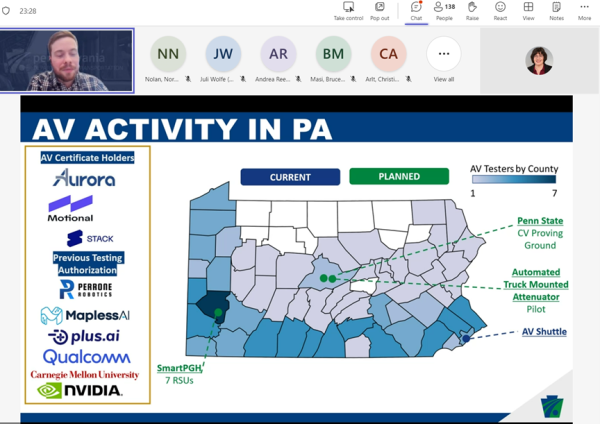Preparing for the Future of Transportation with PennDOT

PennDOT's National Electric Vehicle Infrastructure (NEVI)
On June 12th, WTS Philadelphia teamed with ASHE Delaware Valley to learn about PennDOT’s plans, priorities, and ongoing work on emerging mobility, technologies, and alternative fuels that will shape the future of Pennsylvania’s transportation system via the National Electric Vehicle Infrastructure (NEVI).
Derrick Herrmann, P.E., Chief of Transformational Technology, PennDOT Bureau of Design, Strategic Development and Implementation Office in Harrisburg, was the presenter. He began by discussing the current and future trends in the development and use of automated vehicles. He stated that conditional automation, including steering, acceleration/deceleration and monitoring of the driving environment was already occurring. Automated vehicles already use many tools to help the driver such as short-range radar for blind spot detection and rear collision warnings and ultrasound for parking assistance, but newer tools are coming that will enable adaptive cruise control and pedestrian detection, emergency braking and traffic sign recognition. PA Act 130, which took effect on July 1, 2023, legalizes commercial operations of highly automated vehicles (HAVs) and provides provisions for certification, guidelines and safety. He showed that there is a good deal of automated vehicle testing being done in the PA southern and western counties, especially in Allegheny County.
He talked about the benefits of electric vehicles in that they positively impact climate change as they don’t produce direct greenhouse gas emissions and reduce air and noise pollution among other benefits. He showed that the counties surrounding Philadelphia have by far the largest number of registered electric vehicles in the state. He said that PennDOT wants to increase the number of accessible and reliable charging stations across the state via various grant funding. He said that based on averaging market forecasts and other sources, electric vehicles will likely represent 25-40% of the new light-duty vehicle market and 6-10% of light-duty vehicles on the road in PA by 2030. By 2050, he estimated that it is likely that nearly all new light-duty vehicles will be electric and well over half the vehicles on the road will be electric.
He concluded by siting some other initiatives by PennDOT including an AV Guidebook for Municipalities, additional usage of AI, EV Education and increased Cybersecurity in Transportation. The event, which offered 1 PDH, was well-attended as 138 people tuned into the virtual meeting. Thanks to everyone for joining us!